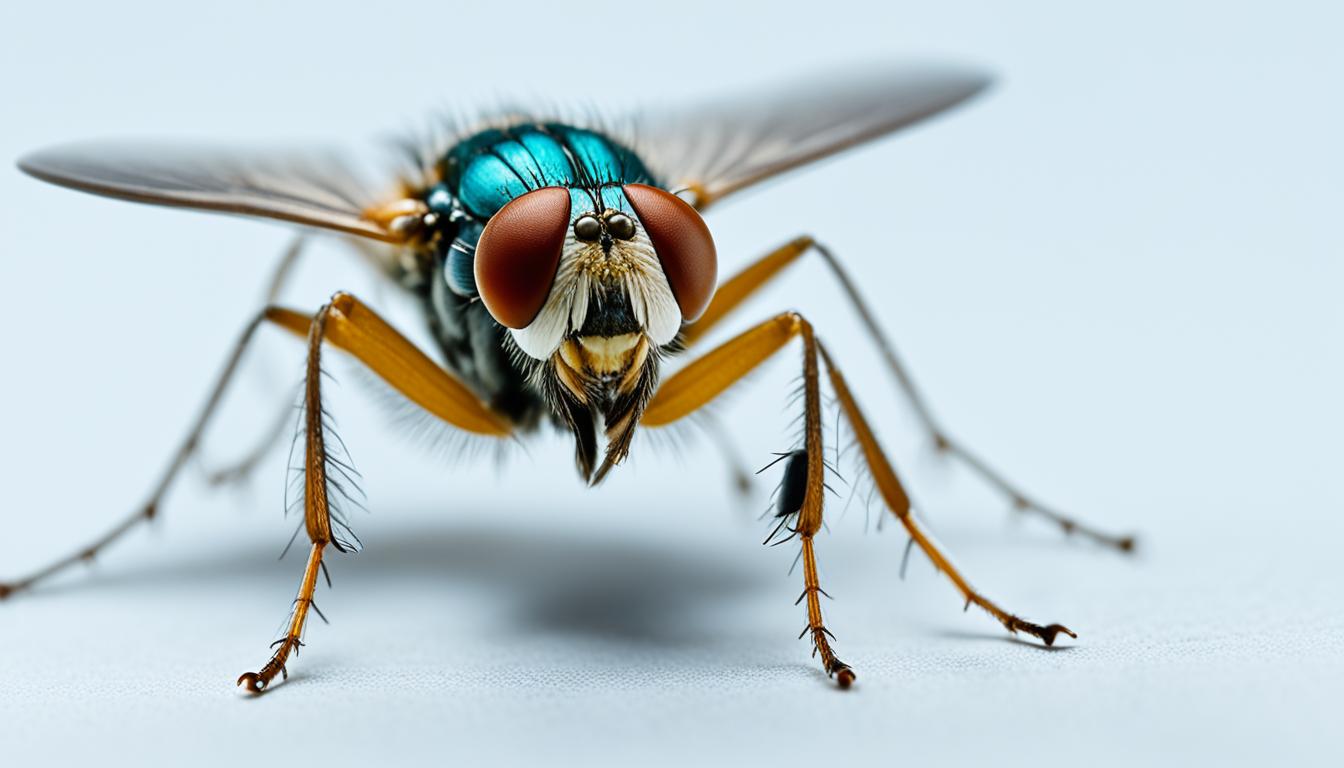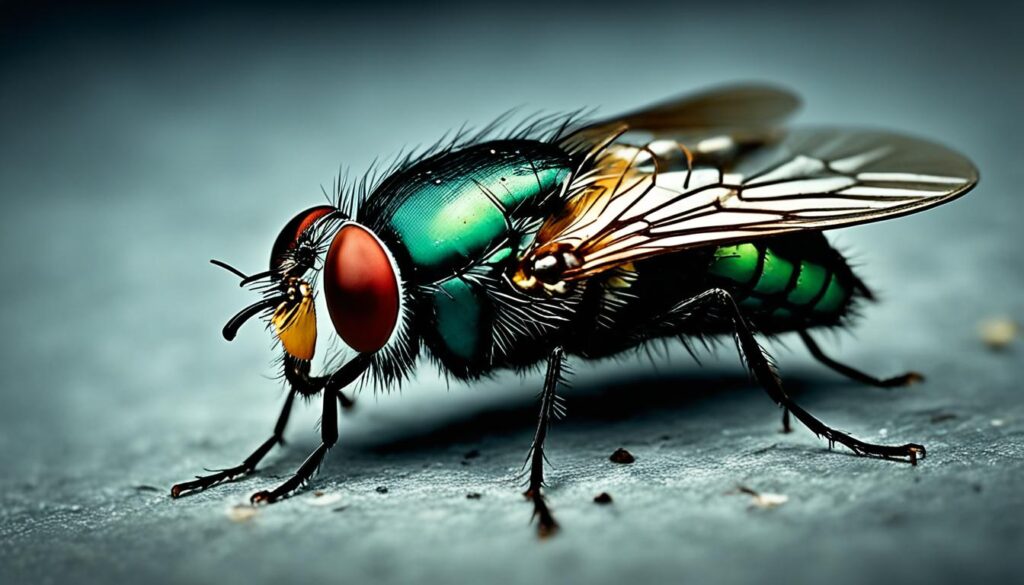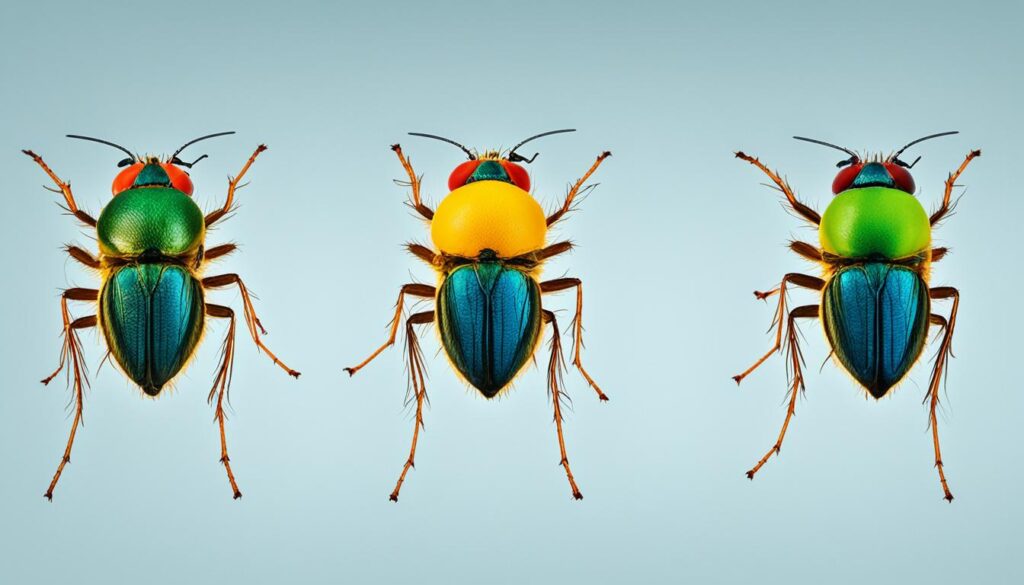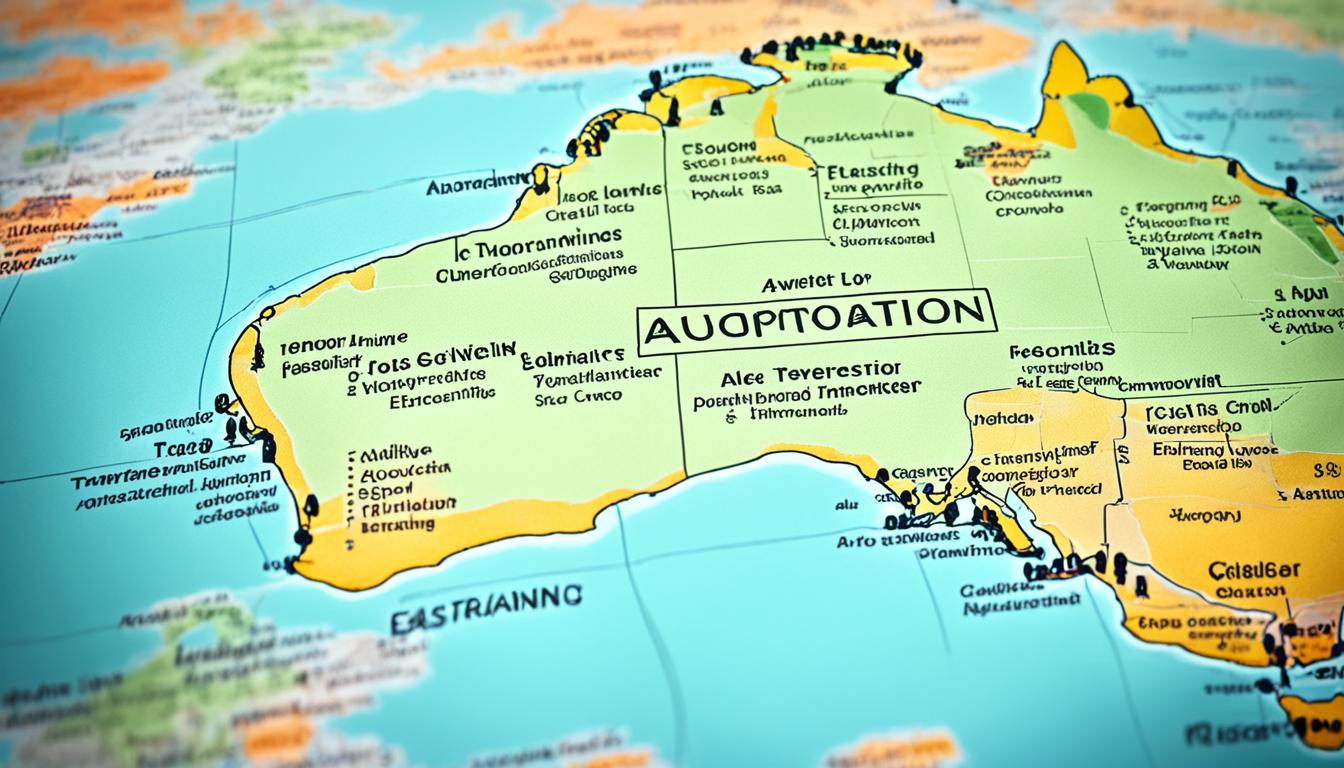
In this comprehensive guide, we will explore the fascinating world of flies and uncover how long they can survive without food. Flies, like any living organism, require sustenance to survive, providing them with the necessary energy and nutrients for essential biological processes.
Key Takeaways:
- Flies can typically survive for about 2 to 3 days without food.
- Their ability to withstand starvation can be influenced by species, age, and environmental conditions.
- Water is equally crucial for their survival, as it provides hydration.
- Flies possess adaptations, such as entering a dormant state known as diapause, to conserve energy and extend their starvation period.
- Factors like temperature, humidity, availability of alternative food sources, and presence of predators can affect their survival without food.
Understanding Fly Lifespan
Before diving into the specific duration that flies can survive without food, it’s important to understand their overall lifespan. Flies typically have a relatively short lifespan, ranging from a few weeks to a couple of months. Factors such as species, environment, and availability of resources can influence their longevity.
Flies are fascinating insects that have captured the curiosity of scientists and entomologists for centuries. Although their lifespans are relatively short compared to other animals, flies play vital roles in ecosystems as decomposers and pollinators.
Species variation is one of the key factors that influence fly lifespan. Different species of flies, such as house flies (Musca domestica) and fruit flies (Drosophila melanogaster), have varying lifespans due to genetic and physiological differences. House flies, for example, typically live for about 15 to 30 days, while fruit flies have a shortened lifespan of around 10 to 14 days.
The environment in which flies live also plays a significant role in determining their lifespan. Flies that inhabit favorable environments with abundant food sources, suitable temperatures, and low predation risk may have longer lifespans compared to those in harsher conditions.
Availability of resources, especially food, is a crucial factor in fly lifespan. Flies require nourishment to survive and reproduce. A diet rich in sugars, proteins, and other nutrients ensures optimal fly health and longevity. Limited access to food can result in shorter lifespans as flies struggle to meet their nutritional requirements.
In addition to these factors, other variables such as temperature, humidity, and exposure to predators can also influence fly lifespans. Flies in warmer environments may have shorter lifespans due to increased metabolic rates and accelerated aging. Higher humidity levels can affect fly survival by promoting the growth of microorganisms that may be detrimental to their health.
Understanding the factors that influence fly lifespan provides valuable insights into their biology and ecological roles. It also aids in developing effective pest management strategies and implementing measures to prevent disease transmission by flies.
To visualize the variations in fly lifespans across species, environments, and resources, refer to the table below:
| Fly Species | Average Lifespan |
|---|---|
| House Fly (Musca domestica) | 15-30 days |
| Fruit Fly (Drosophila melanogaster) | 10-14 days |
| Blow Fly (Calliphoridae) | 2-4 weeks |
| Hoverfly (Syrphidae) | 1-3 months |
As you can see, fly lifespans can vary significantly depending on the species. These variations are influenced by genetic factors, environmental conditions, and available resources. By understanding the factors that impact fly lifespans, we can gain a deeper appreciation for these remarkable insects and the role they play in our ecosystems.
The Importance of Sustenance
Flies, like any living organism, require sustenance to survive. Food provides them with the necessary energy and nutrients for various essential biological processes. Without food, their survival becomes a challenging endeavor. Let’s explore how long flies can endure without eating.
As small and agile creatures, flies have developed impressive adaptations that enable them to thrive in diverse environments. While they are often regarded as pests due to their presence in human dwellings, flies play important roles in ecosystems as decomposers, aiding in the natural breakdown of organic matter.
However, to understand a fly’s survival without food, it is vital to recognize the significance of sustenance in their daily lives. With sturdy mouthparts designed for various feeding habits, flies have evolved to capitalize on available food sources.
The Nutritional Importance of Food
Food serves as fuel for flies, sustaining their bodily functions and supporting their metabolic processes. It provides the essential nutrients and energy necessary for activities such as flying, mating, and reproduction.
Flies have a diverse diet that ranges from sugars and nectar to decomposing organic matter. Some species are even known to feed on blood or decaying animal carcasses. This versatility enables them to locate nourishment in various environments.
“Food is not just a source of sustenance for flies; it is their lifeline. Without it, their survival is compromised.”
Despite their resourcefulness, flies cannot survive indefinitely without food. Like all organisms, they have limits to their survival abilities.
The Limits of Survival
Without access to enough food to sustain themselves, flies face challenges in meeting their physiological needs. Their bodies gradually deplete their energy reserves, leading to a decline in motor function and other biological processes.
A fly’s ability to survive without food is influenced by various factors, including species, environmental conditions, and individual adaptations. Some species may have greater resilience and tolerate longer periods of starvation than others.
On average, a fly can typically endure without food for about 2 to 3 days. However, it’s important to note that this duration is not absolute and can be affected by external factors. For example, certain conditions such as extreme temperatures or low humidity can accelerate their energy consumption and shorten their survival time.
The Role of Water in Fly Survival
While food is essential, water is equally crucial for a fly’s survival. Flies need to stay hydrated to maintain their bodily functions and prevent dehydration.
Flies can often find water sources in their environment, such as puddles, plant leaves, or even condensation on surfaces. These water sources can extend their survival period even when food is scarce.
| Factors Influencing Fly Survival without Food | Duration without Food |
|---|---|
| Species | Varies – Some species can survive longer than others |
| Environmental Conditions | Varies – Extreme temperatures and low humidity can shorten survival time |
| Individual Adaptations | Varies – Certain flies may have greater resilience to food scarcity |
Note: The table above highlights the factors that influence a fly’s survival without food.
Understanding the importance of sustenance in the lives of flies gives us valuable insights into their survival abilities. While they possess remarkable adaptations to withstand food scarcity for a limited time, providing a suitable environment for flies and implementing effective pest management practices can help mitigate their presence in human spaces.
Next, we will delve deeper into the specifics of how long flies can go without eating and the various factors that influence their survival without food.
Under Deprivation: How Long Can Flies Go Without Food?
Flies are remarkably adaptable creatures, capable of surviving challenging conditions. When it comes to sustenance, a fly can generally endure without food for approximately 2 to 3 days.
This duration, however, is not set in stone. Various factors come into play that can influence how long flies can survive without eating. Species, age, and surrounding environmental conditions all contribute to the overall resilience of flies under deprivation.
It’s important to note that this survival period is an average estimate and may differ among different fly species. Some species may be more resilient and able to withstand an extended period without food, while others may have shorter survival durations.
In the face of scarce resources, flies exhibit remarkable adaptations to aid their survival.
Research has shown that flies can enter a dormant state known as diapause when subjected to prolonged deprivation. During diapause, their metabolic rate significantly slows down, allowing them to conserve energy and prolong their survival even without access to food.
The Impact of Environmental Conditions
The duration flies can go without food can also be influenced by surrounding environmental conditions. Factors such as temperature, humidity levels, and the availability of alternative food sources play a significant role. Flies tend to survive longer in favorable environmental conditions, where resources are more abundant.
Varying Survival Durations
Not all flies are alike in their ability to survive without eating. For instance, houseflies (Musca domestica) have been observed to endure slightly longer periods without food compared to fruit flies (Drosophila melanogaster). These differences in survival durations can be attributed to variations in their biological makeup and evolutionary adaptations.
| Fly Species | Average Duration Without Food |
|---|---|
| Housefly (Musca domestica) | Approximately 2-3 days |
| Fruit fly (Drosophila melanogaster) | Approximately 1-2 days |
| Blowfly (Calliphoridae) | Approximately 1-2 days |
Above all, it is important to remember that the ability for flies to survive without food is ultimately dependent on a combination of factors. Further research and scientific studies continue to shed light on the complexities of fly survival and provide valuable insights into how these insects navigate challenging circumstances.
The Importance of Water
While flies can survive for a limited time without food, their need for water is equally crucial. Water provides hydration, a vital component for their survival. Flies can often find water sources in their environment, extending their survival period even if food is scarce.
Water is essential for numerous physiological processes in flies, such as digestion, respiration, and reproduction. It helps maintain their body temperature and enables them to regulate internal processes effectively.
Flies are adept at locating water sources to quench their thirst. They are known to seek moisture from various places, including damp areas, puddles, water bodies, and even household faucets. Their ability to find water is crucial in sustaining their survival during periods of fly starvation.
However, while flies rely on water for survival, they are also at risk of drowning if they become trapped in liquid substances. As such, their search for water sources can sometimes lead to hazardous situations, particularly in urban environments where they may encounter pools of chemicals or other harmful substances.
It is important to remember that while flies can survive for a limited period without food, the combination of food and water scarcity drastically reduces their chances of survival. Without these essential resources, their energy reserves deplete rapidly, leading to a weakened state and eventual death.
Water Sources for Flies
Flies have a remarkable ability to locate water sources, and they often take advantage of available options in their surroundings. Here are some common water sources that flies may rely on:
- Puddles and small bodies of water
- Moist areas, such as damp soil or wet surfaces
- Water containers and storage units
- Open faucets and drains
- Outdoor water features, like ponds or fountains
These water sources provide flies with the hydration they need to survive and extend their longevity in the absence of food.
Comparative Survival Periods of Flies Without Food and Water
| Fly Species | Survival Period without Food (Days) | Survival Period without Food and Water (Days) |
|---|---|---|
| House Fly (Musca domestica) | 2-3 | 1-2 |
| Fruit Fly (Drosophila melanogaster) | 7-10 | 3-5 |
| Blow Fly (Calliphoridae) | 7-14 | 5-7 |
| Stable Fly (Stomoxys calcitrans) | 7-30 | 5-10 |
Table: Comparative survival periods of different fly species without food and water.
As seen in the table above, fly species exhibit varying survival periods without food and water. These durations depend on factors such as the species’ adaptations, environmental conditions, and individual resilience. It is important to note that these durations are general estimations and may vary in different situations.
Adaptations for Survival
Flies possess remarkable adaptations that aid their survival during periods of food scarcity. One of their key strategies is the ability to enter a dormant state known as diapause. During diapause, the metabolic rate of flies slows down significantly, allowing them to conserve energy and extend their starvation period.
Diapause is a natural survival mechanism that enables flies to withstand unfavorable conditions, such as cold weather or lack of food. This adaptation allows them to temporarily suspend their growth and development until more favorable conditions arise.
During diapause, flies become less active and show reduced feeding behavior. Instead of actively searching for food, they rely on stored reserves and metabolic adjustments to sustain themselves. This ability to conserve energy and nutrients enables flies to survive for an extended period without food.
Flies have evolved this adaptive strategy to cope with the unpredictable availability of food resources in their environment. It is a survival mechanism that helps them endure periods of fly starvation and increases their chances of survival until suitable sustenance becomes available again.
In addition to diapause, flies also have other adaptations that aid their survival. They are equipped with highly efficient digestive systems that enable them to extract the maximum amount of nutrients from their food. This efficient digestion helps them make the most of the limited food resources they encounter.
Furthermore, flies have a rapid life cycle, allowing them to reproduce quickly and produce a large number of offspring. This high reproductive potential ensures the continuation of the species even during adverse conditions when food is scarce.
Overall, the adaptations of diapause, efficient digestion, and rapid reproduction enable flies to increase their chances of survival during periods of fly starvation. These remarkable strategies highlight the resilience and adaptability of these insects in the face of challenging circumstances.

Factors Influencing Survival Period
The duration flies can survive without food can vary depending on several factors. These factors play a crucial role in determining how long flies can endure without sustenance and can provide valuable insights into their adaptability and resilience.
1. Species of Fly
The species of fly can significantly impact their survival period without food. Different species have varying physiological and behavioral adaptations that allow them to withstand starvation for varying lengths of time. Some species may have evolved to survive longer periods without food, while others may have shorter survival thresholds.
2. Availability of Alternative Food Sources
A fly’s ability to find and utilize alternative food sources in its environment can affect its survival period without access to its usual sources of sustenance. Flies are opportunistic feeders and can scavenge for nutrients from various organic matter. The presence or absence of alternative food sources can extend or shorten the time flies can survive without food.
3. Temperature and Humidity Levels
The surrounding temperature and humidity levels are critical environmental factors that can influence a fly’s survival without food. Flies are ectothermic organisms, meaning their body temperature is regulated by the temperature of their surroundings. Low temperatures can slow down their metabolic rate, allowing them to conserve energy and survive longer periods without food.
4. Genetic Factors
Genetic factors can also impact a fly’s ability to withstand starvation. Genetic variations within a species can result in differences in metabolic efficiency, energy storage, and other physiological adaptations that affect their survival without food. These genetic factors contribute to the overall variability in fly lifespans and survival abilities.
To better understand the complex interplay between these factors and their influence on fly survival, further research and studies are continuously conducted. This ongoing exploration helps deepen our understanding of these remarkable creatures and their remarkable abilities to adapt and survive in different conditions.
Life Cycle and Survival
Understanding the life cycle of a fly is crucial in comprehending their ability to survive without food. Flies undergo several stages of development, including the egg, larva, pupa, and adult stages. Each stage contributes to their overall survival and influences the duration they can go without food.
During the larva stage, flies primarily feed on organic matter, such as decaying food or animal waste. This stage is essential for their growth and provides them with the necessary energy to progress into the pupa stage. The pupa stage is a transformative phase where the fly undergoes internal changes, preparing to emerge as an adult.
Once a fly reaches adulthood, their primary focus shifts to reproduction and finding sources of sustenance. Their ability to find food becomes crucial for their survival, as adult flies require regular nourishment. However, the length of each stage in their life cycle can have an impact on how long they can go without food.
| Stage | Duration | Key Characteristics |
|---|---|---|
| Egg | 1-2 days | Small, oval-shaped, laid in organic matter |
| Larva | 4-7 days | White, maggot-like appearance, feed on organic matter |
| Pupa | 5-14 days | Inactive, cocoon-like stage, undergoes internal changes |
| Adult | 2-3 weeks | Ability to fly, seek mates and food sources |
The length of each stage can vary depending on factors such as species, temperature, and availability of resources. For example, warmer temperatures can accelerate the fly’s life cycle, resulting in shorter durations for each stage. Conversely, cooler temperatures can extend the duration of each stage, potentially affecting their ability to survive without food.
It’s important to note that the fly’s ability to endure food deprivation is intricately linked to their life cycle and the stage they are in. While adult flies can typically survive for a few days without food, younger or immobile stages, such as eggs and pupae, may be more resilient and can withstand longer periods of food scarcity.
Supporting Survival Strategies
Each stage in the fly’s life cycle serves a unique purpose, contributing to their overall survival. The ability to enter a dormant state, such as pupation, allows the fly to conserve energy and endure food shortages. This adaptive strategy helps them withstand adverse conditions and increase their chances of survival.
In addition, flies have evolved to possess other adaptations, such as sponging mouthparts and regurgitation, which enable them to consume liquefied food sources when solid food is scarce. These adaptations provide them with alternative ways to obtain sustenance and extend their survival period without direct access to solid food.
By understanding the life cycle of flies and their survival strategies, we can gain valuable insights into their ability to endure food scarcity. This knowledge contributes to effective pest management and aids in developing strategies that minimize the impact of flies in various environments.
Feeding Habits and Adaptations
Flies have diverse feeding habits and adaptations that allow them to survive in various environments. Understanding these adaptations is crucial in comprehending their ability to endure periods of food scarcity and their potential survival without eating.
“Adaptation is the key to survival in the natural world. Flies have developed remarkable feeding strategies that enable them to find sustenance even in challenging conditions.”
Opportunistic Feeders
Some fly species are opportunistic feeders, meaning they have the ability to consume a wide variety of organic matter. They scavenge for food sources such as decaying plants and animals, garbage, and even feces. This adaptability allows them to find sustenance even in harsh environments where traditional food sources may be scarce.
Specialized Diets
On the other hand, certain fly species have specific dietary preferences. For example, fruit flies are attracted to overripe or fermenting fruits, while flesh flies feed on dead or decaying animal flesh. These specialized diets indicate their ability to exploit specific food sources, ensuring their survival when such resources are available.
Hunting Strategies
Some fly species, such as horse flies and robber flies, are predatory in nature. They actively hunt and capture other insects to satisfy their nutritional needs. These flies have evolved adaptations like sharp mouthparts and agile flight maneuvers that aid in catching prey. Their predatory behavior makes them less reliant on traditional food sources and increases their chances of survival during periods of food scarcity.
Comparing Fly Feeding Adaptations
Let’s explore the different feeding habits and adaptations of various fly species in the table below:
| Fly Species | Feeding Adaptation |
|---|---|
| Fruit Flies (Drosophila) | Feed on overripe or fermenting fruits |
| Flesh Flies (Sarcophaga) | Feast on dead or decaying animal flesh |
| Mosquitoes (Culicidae) | Suck blood from humans and animals |
| House Flies (Musca domestica) | Scavenge on decaying organic matter, including garbage and feces |
| Horse Flies (Tabanidae) | Predatory, feeding on other insects and occasionally blood |
These examples highlight the diverse feeding adaptations observed among different fly species. Their ability to exploit a variety of food sources ensures their survival in dynamic and often challenging environments.
Now that we understand fly feeding habits and adaptations, let’s delve deeper into the factors influencing the duration flies can survive without food.
Environmental Influences
Flies, being highly adaptable insects, are significantly influenced by their environment when it comes to survival. Various factors play a crucial role in determining how long flies can live without food. Let’s explore these environmental influences in detail:
Temperature
The temperature of the surrounding environment directly affects the metabolic processes of flies. Higher temperatures tend to accelerate the fly’s metabolism, increasing their energy expenditure. Conversely, lower temperatures can slow down their metabolic rate, allowing them to conserve energy and extend their survival without food.
Humidity
Humidity levels also impact a fly’s ability to survive without food. Flies, like many other insects, require a certain level of humidity to prevent dehydration. In environments with high humidity, flies are more likely to retain moisture, enabling them to survive longer periods without food.
Availability of Alternative Food Sources
When their primary food sources are scarce, flies have the ability to feed on a wide range of organic matter. This adaptability enhances their survival chances during times of food scarcity. The presence of alternative food sources in the environment can significantly prolong the duration a fly can survive without ingesting a proper meal.
Presence of Predators
The presence of natural predators such as spiders, birds, or other insects can impact the survival of flies. Flies utilize various defensive mechanisms to avoid becoming prey, but the constant threat of predation can influence their behavior and ability to find food. In environments with fewer predators, flies may have a better chance of surviving without food for longer periods.
| Factors | Influence |
|---|---|
| Temperature | Affects metabolic processes and energy expenditure. |
| Humidity | Impacts hydration levels and prevention of dehydration. |
| Availability of Alternative Food Sources | Allows flies to sustain themselves when primary food is scarce. |
| Presence of Predators | Influences behavior and ability to find food. |
These environmental influences can significantly affect how long flies can survive without food. By understanding the interplay between flies and their surroundings, we can gain valuable insights into their adaptive capabilities and improve our pest management strategies.
Flies and Disease Transmission
Flies are not just pesky insects buzzing around; they can also pose a threat to human health. These common pests often come into contact with various microorganisms, including disease-causing pathogens. Their potential to transmit diseases makes understanding their lifespan and survival abilities without food all the more important.
“Flies are not just pests; they are scavengers, transmitting more diseases than any other insect.”
Flies can pick up pathogens from their surroundings, including decaying organic matter, garbage, and even feces. As they land on food, surfaces, or even human skin, they can transfer these disease-causing microorganisms, thereby increasing the risk of infection.
Proper sanitation practices play a crucial role in mitigating the risk of disease transmission by flies. By maintaining clean and hygienic environments, you can significantly reduce the chances of contamination and protect yourself and others from potential illnesses.
Regular cleaning, proper waste management, and prompt disposal of organic matter are essential steps to prevent flies from accessing potential breeding and feeding grounds. Additionally, keeping doors and windows screened can help prevent their entry into your living spaces.
Understanding the lifespan of flies and their ability to survive without food further emphasizes the importance of sanitation practices. By disrupting their access to food sources, you can actively discourage their presence and minimize the risk of disease transmission.
The Role of Proper Sanitation:
- Regular cleaning and maintenance of living spaces
- Proper waste management and prompt disposal
- Screening doors and windows to prevent fly entry
By adopting these practices, you can ensure a cleaner and healthier environment, reducing the chances of disease transmission by flies.

In summary,
Flies’ potential to carry and spread diseases underscores the importance of understanding their lifespan and survival without food. By implementing proper sanitation practices, you can minimize the risk of disease transmission and create a safer living environment for you and your loved ones.
Pest Management Strategies
Flies can be a nuisance and pose health risks in certain settings. Understanding the duration they can survive without food aids in developing effective pest management strategies. By removing their food sources and implementing appropriate control measures, the infestation can be minimized.
- Remove potential food sources: Flies are attracted to organic matter such as food scraps, garbage, and pet waste. Regularly clean and dispose of these items to eliminate potential food sources and discourage fly infestations.
- Ensure proper sanitation: Keeping the environment clean and maintaining good hygiene practices can reduce the chances of flies breeding and spreading diseases. Regularly clean surfaces, empty trash bins, and seal any potential entry points.
- Use fly traps and baits: Fly traps and baits can be effective tools in reducing fly populations. These devices attract flies and capture them, helping to control their numbers. Choose traps and baits suitable for the specific fly species you are dealing with.
- Implement exclusion methods: Prevent flies from entering your space by installing window screens, door sweeps, and air curtains. These physical barriers can help keep flies out while allowing fresh air ventilation.
- Consider biological control options: Introduce natural predators or parasitic organisms that target flies into the environment, such as certain wasps or nematodes. These biocontrol agents can help suppress fly populations.
- Seek professional help: In severe fly infestations or situations where DIY methods are unsuccessful, it may be necessary to consult professional pest control services. Experts can assess the situation, identify the species of fly, and implement targeted strategies for effective control.
By adopting these pest management strategies, you can minimize fly infestations, reduce health risks, and create a more pleasant and hygienic environment.
Research and Future Studies
Scientists are continuously delving into the world of flies, conducting extensive research to unravel the mysteries behind their biology, survival strategies, and lifespan. These ongoing studies contribute to advancements in pest control, disease prevention, and our overall knowledge of these remarkable insects.
Exploring the fly lifespan is crucial for developing effective pest management techniques and strategies for curbing disease transmission. By understanding their biology and survival mechanisms, scientists can devise innovative solutions to mitigate the negative impacts of flies in various environments.
A deeper understanding of fly lifespan aids researchers in identifying key factors that influence their survival. This knowledge can then be used to establish guidelines for preventing infestation and controlling fly populations in areas where they pose a significant threat.
Furthermore, by studying fly biology and behavior, scientists gain insights into the complex interplay between flies and diseases. This research helps in developing proactive measures to reduce disease transmission caused by flies, safeguarding public health.
As the field of entomology continues to advance, researchers are discovering new aspects of fly lifespan and survival strategies. Ongoing studies provide valuable information that can be utilized in various disciplines, including agriculture, environmental science, and public health.
Through the collaborative efforts of scientists worldwide, innovative techniques and technologies are being developed to study flies more comprehensively. These advancements allow for a deeper understanding of the factors that affect fly lifespan, contributing to the creation of environmentally-friendly and sustainable fly control measures.
“The study of fly lifespan opens up a world of possibilities for pest control and public health management. By uncovering the secrets behind their survival, we can develop strategies to minimize their impact and protect human well-being.”
– Dr. Emily Carter, Entomologist
Advancements in Fly Research
Research on fly lifespan extends beyond basic understanding and directly impacts pest management practices. The following are some notable advancements that have emerged from ongoing studies:
- Identification of genetic factors influencing fly survival and lifespan.
- Development of novel fly control methods, including trap design and targeted biological interventions.
- Investigation of fly behavior and feeding adaptations, leading to more effective management approaches.
- Exploration of the influence of environmental factors, such as temperature and humidity, on fly lifespan and population dynamics.
Recent Discoveries in Fly Research
| Research Finding | Impact on Fly Control |
|---|---|
| Fly species exhibit varying lifespan durations due to genetic variations. | Customized control measures can be developed based on species-specific characteristics. |
| Dormant stages in the fly life cycle contribute to increased survival. | Targeting specific life stages can disrupt fly populations more effectively. |
| Understanding fly feeding preferences aids in the development of targeted baits and traps. | Improved trap efficacy leads to better fly control. |
| Environmental factors, such as temperature fluctuations, influence fly lifespan and reproductive rates. | Strategies can be devised to counteract environmental influences and reduce fly populations. |
Human-Fly Interactions
Flies have a long history of coexistence with humans, often found in our homes, farms, and outdoor spaces. Understanding their survival abilities and behavior can help us develop strategies to peacefully coexist and prevent potential negative impacts on human health and well-being.
Flies are highly adaptable insects capable of surviving in diverse environments, including those created by human activities. Their presence can be a nuisance, but by understanding their biology and habits, we can implement effective measures to manage their populations and minimize their impact.
Fly Behavior and Habitat
Flies are attracted to food sources, waste, and decaying organic matter, making our homes and farms attractive habitats for them. Understanding their preferences and breeding habits can help us identify areas where they are likely to congregate or lay eggs.
Flies are also known to transmit diseases, including gastroenteritis and cholera, by contaminating food and surfaces with pathogens they carry on their bodies. Proper sanitation practices, such as keeping food covered and removing waste promptly, can help reduce the risk of disease transmission.
Best practices for coexisting with flies
- Keep living spaces clean and free of potential food sources for flies.
- Seal garbage bins tightly to prevent flies from accessing waste.
- Use screens on windows and doors to keep flies from entering indoor spaces.
- Remove standing water and other sources of moisture, as flies are attracted to these environments.
- Implement integrated pest management strategies, including the use of traps and biological controls, to manage fly populations.
By following these best practices and understanding their behavior, we can create an environment that discourages fly infestations and minimizes the potential negative impacts on human health and well-being.
“Understanding the biology and behavior of flies is crucial for effective pest management and disease prevention. By implementing simple measures in our homes and outdoor spaces, we can peacefully coexist with these insects while safeguarding our health and well-being.” – Pest Control Expert
Common Fly Species and Habitats
| Fly Species | Common Habitats |
|---|---|
| Housefly (Musca domestica) | Kitchens, garbage areas, livestock facilities |
| Fruit Fly (Drosophila spp.) | Fruit markets, kitchens, compost bins |
| Blowfly (Calliphoridae spp.) | Decaying animal matter, garbage areas, carrion |
| Stable Fly (Stomoxys calcitrans) | Stables, livestock areas, outdoor dining areas |
Understanding the common fly species and their preferred habitats can help us identify potential problem areas and take appropriate preventive measures.
Remember, fly survival without food hinges on their ability to find suitable habitats and food sources. By implementing effective pest management practices and maintaining proper sanitation, we can create an environment that discourages flies from lingering in our living spaces.
Environmental Impact
Flies, while often viewed as pesky nuisances, actually play a critical role in ecosystems as decomposers. These tiny creatures aid in breaking down organic matter, facilitating the recycling of nutrients back into the environment. Their presence and ability to survive without food contribute to the balance of natural processes.
Flies possess remarkable adaptations that enable them to thrive in various habitats. Their short lifespan of a few weeks to a couple of months allows them to rapidly reproduce and fulfill their ecological role. However, their ability to survive without food for a limited period further highlights their resilience in the face of adversity.
By understanding the fly lifespan and their capacity to endure without sustenance, we can truly appreciate the crucial ecological function they fulfill. These small insects not only aid in the decomposition process but also support the overall health and equilibrium of ecosystems.
| Environmental Impact of Flies | |
|---|---|
| 1. Decomposition | Flies assist in the breakdown of organic material, contributing to nutrient cycling and soil health. |
| 2. Ecosystem Maintenance | Their presence helps maintain the balance of natural processes and contribute to overall ecosystem stability. |
| 3. Nutrient Recycling | By breaking down organic matter, flies play a vital role in returning nutrients back to the environment. |
While flies may be seemingly insignificant, their impact on ecosystems cannot be understated. They are an integral part of the intricate web of life, playing a crucial role in maintaining ecological equilibrium.
“Flies aid in the breakdown of organic matter, contributing to nutrient cycling and soil health.”
Preserving Ecological Balance
It is important to recognize the role of flies in the larger context of environmental conservation. By implementing sustainable practices and maintaining proper waste management, we can create environments that coexist harmoniously with flies and other decomposers.
Moreover, understanding the factors that influence fly lifespan and their ability to survive without food can inform pest management strategies that minimize negative impacts on human health and well-being. By adopting comprehensive approaches that consider ecosystem dynamics, we can strike a balance that both supports the natural world and meets our own needs.
Conclusion
In conclusion, flies are resilient insects that can typically survive for about 2 to 3 days without food. However, this duration can vary depending on factors such as species, environmental conditions, and individual adaptations. Understanding the survival abilities of flies is crucial for effective pest management and disease prevention.
By coexisting with flies in a balanced manner, you can appreciate their role in ecosystems while mitigating potential risks. Flies play an important role as decomposers, aiding in the natural process of breaking down organic matter.
Whether it’s implementing proper sanitation practices, removing their food sources, or developing pest management strategies, it’s essential to take into account the unique characteristics of flies to ensure a harmonious coexistence.







